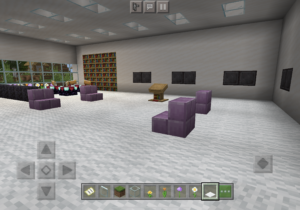Week 7: Minecraft Build and the Process Approach to Writing

Thus far, in this course, I’ve learnt many new theories and approaches, such as instrumentalism, essentialism, post-humanism, transhumanism and constructivism, among others. More importantly, I’ve learnt to question rationales.
I started this block with a post on my ideal learning space. After completing this block’s core readings, and reflecting on my reading from the previous blocks, I began to question my rationale for doing so. The ideal learning space I had come up with was one that was supposedly conducive for learning, but did it actually take into account how learning happens?
So, I decided to return to the basics. Most of my work involves writing. I am either writing or teaching others how to write. And, one fundamental rule that I constantly remind my students of is: purpose, audience, context (PAC). In (re)designing my Minecraft learning space, I started off with PAC as a framework.
Purpose: to teach students how to write (and to some extent, how to think)
Audience: undergraduates, who have content knowledge but needed help honing their writing skills
Context: writing for academic purposes, and this involves formulating research questions, conducting some research, reviewing literature and presenting arguments
Next, I thought about how the writing process. Zamel (1983) proposes that the writing process is a ‘non-linear, exploratory generative process where writers discover and reformulate their ideas as they attempt to approximate meaning (p. 166). Hence, the process approach to writing views writing as consistent of several constituent composing components. These components, as identified by Flower and Hayes (1981), are:
- planning, where ideas are generated and organized, and goals are set;
- translating, where ideas are converted into written or spoken language; and
- reviewing, where the writer evaluates and revises what he or she has written.
The process approach basically charts a student’s learning journey when it comes to writing. A student would move forwards from the planning stage to translating stage, but it is also possible for him or her to move backwards to the first two stages upon reviewing the final product.
Therefore, I decided to design my Minecraft learning space with my PAC, initial criteria for an ideal learning space and the process approach in mind.
I started out by creating what I call a “research nook” (see the top left of my picture) that resembles a traditional library. This area symbolizes the planning stage. Instead of being filled with books, the shelves will house iPads and tablets. Students can easily access electronic resources using these gadgets, removing the need to search a physical library for learning material. They can use the tables to collaborate and discuss.
To the left is the “teaching area” . The teacher can utilise this area to conduct his or her teaching. The furniture can be reconfigured to suit the activity. I am a strong believer of student involvement in the classroom. Therefore, I added screens so that students can showcase their work or use them for presentations. This area represents the translating phase, as the students (as well as the teacher) are translating ideas into written or spoken language here.
Lastly, I’ve left a rather symbolic “open space” to represent the reviewing stage. Here, students can either reflect individually or seek feedback from their peers or teacher in a more informal setting, that is similar to how guests mingle over cocktails before the start of an event.
It is important to note that three spaces I’ve created are not exclusive to their respective stages of the process approach. Planning can happen in the teaching area and reviewing can take place in the research nook. Students can plan their group writing by discussing the topic at one of the tables and use the iPads to take notes. Or, they could do some peer-marking here. The main idea here is flexibility and mobility. Students should be allowed to move freely between these space as they do with the different stages of the writing and thinking processes.
References:
Flower, L., & Hayes, J. (1981). A cognitive process theory of writing. College Composition and Communication, 32(4), 365-387. doi:10.2307/356600
Zamel, V. (1983). The composing processes of advanced ESL students: Six case studies. TESOL Quarterly, 17(2), 165–187. https://doi.org/10.2307/3586647




Excellent post using a well-structure argument and theoretical justification for your space.
Glad you’ve understood one of this course’s core messages – critically question everything.